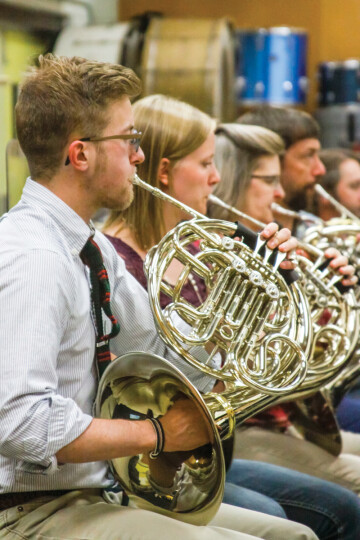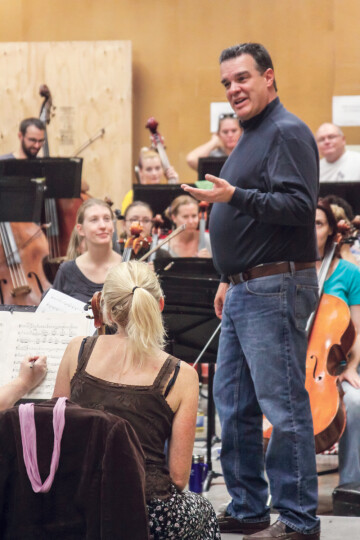The Real Fun: What It Takes to Join the Orchestra
photos by Zach Hoffman | Saturday Oct. 1st, 2016
Have you ever wondered what it is like to play in a symphony orchestra? You see 75 people perfectly in sync with one another working hard to produce such glorious sounds. It’s magical—and looks to be so much fun. Well it is fun, but there’s a lot to it, and my hope is that, after reading this, you’ll develop an entirely new appreciation for the members of your orchestra; The Bozeman Symphony.

Before you decide if you want to play in an orchestra, there’s one thing you need to know: Those of us up on stage say we “play” music, but it’s not play at all. It’s work; hard work. It takes dedication, persistence, and skill. Oh, and given the subjective nature of it all, you are never satisfied. You always want to do better.
So here’s how you get on stage. First you’ll need to audition. What matters here is not your resume, or your people skills, but how you actually play your instrument. You’ll be assigned a number of orchestral excerpts—famous moments in the repertoire for your instrument—and a solo piece, usually a movement of a well-known concerto. If it’s a competitive audition, meaning there are several people vying for one spot, then there will be several rounds throughout the day. The first round will last approximately 8 to 15 minutes. You’ll be ushered into a room or a stage and you’ll sit behind a curtain where no one else can see you. Even the famous are anonymous here. Then a voice from the committee will instruct you what to play from the list of repertoire you have been assigned to prepare. After playing just a bit of that repertoire, the committee will thank you and you will be excused. If all goes well you might make it to the next round. This goes on until one person is chosen.
Once you’ve been selected the real work begins. You’ll be given your music two weeks prior to the first rehearsal of each concert. American orchestras have very condensed rehearsal schedules, often just 2 to 4 rehearsals within 3 or 4 days of the performance. This means you’ll need to come fully prepared for the first rehearsal. You’ll need to research the repertoire by finding recordings and listening carefully, noting stylistic differences as well as practical things like fingerings, bowings and tempo. Then you’ll need to learn the part fully. There is no time in rehearsal to learn your notes as rehearsals are designed to get 75 people to play perfectly together, and to understand the depth of the notes you’ve learned in advance. My guess is that the typical orchestra member must put in a minimum of 15 hours of practice before the first rehearsal.

Rehearsals will be intense, and it’s here where both your love of playing and your passion for music will be tested. We have to rehearse 75 to 80 minutes of music in a 2 ½ hour period, fitting in a 15 minute break in the middle. Total focus and discipline is required. The conductor will try his or her best to milk every second of that time so don’t think you’ll have many chances to chat with your neighbor. You will be working every moment you are there.
During each rehearsal the conductor will ask you to play things differently than you have prepared. You’ll need to be able to adjust immediately or, at the very least, make good notes of that spot and go home and practice the changes before the next rehearsal—and you will be putting in an hour or two in the practice room between each rehearsal. No detail will be left to chance, and everyone must be devoted to achieving the goal of realizing the composer’s intentions.
After all the practicing and rehearsals it’s finally concert-time. You will arrive at the concert hall full of anticipation—and maybe even a bit nervous. You need to be constantly aware of everything going on around you. If you or someone else in the orchestra makes a mistake, you’ll need to know how to help fix it on the spot. You’ll rely on all of your skills and a heightened sense of awareness, and you will need to keep your mind free from any and all distraction. You’ll need to give yourself fully to the composer, the ensemble, and the audience.
As the concert comes to a conclusion and you experience the applause of the audience, you will feel a rush of exhilaration and pride, but you will also reflect on what could have been done better. Nonetheless, that feeling of communal pride—of being part of a large group all working toward the same goal—will overwhelm you. And then you’ll discover a kind of fun rarely matched in the human experience.

The truth is that playing in an orchestra is relentlessly hard work, and for very little reward. Players are paid a “per-service” fee (a service being anytime they play a rehearsal or performance) which, when you add in the hours they have to prepare on their own time, comes to less than minimum wage, and often isn’t even enough to pay for the maintenance of their instrument.
When I was just starting my work in Bozeman, my conducting mentor Gustav Meier said to me “Now Matthew, remember that they just want to have fun. But the real fun—the REAL fun—is playing at their very best, and that is what they expect you to get from them.” What I learned from this advice is that there is self-esteem and there is what I call “false-esteem.” False-esteem comes from just doing ok—just doing your job. Self-esteem comes from nailing it—and that only is achieved through hard work and dedication.
In the end it’s not the conductor, soloist, or even the composer who are the real heroes. It’s the players and singers who deserve that status. The members of the Bozeman Symphony Orchestra and Symphonic Choir put themselves through rigors that most people would avoid, and all in the service of something bigger than themselves. They work to present you with the finest performances possible of the greatest music ever written. It’s not at all easy, but when we nail it—when that hard works comes to a crescendo of a great performance—that’s fun!
Matthew Savery is the Music Director and Conductor of the Bozeman Symphony Orchestra and Symphonic Choir, and the Wyoming Symphony Orchestra.
| Tweet |
